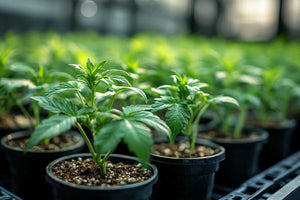Gardening brings joy to many individuals, providing satisfaction as seeds germinate in warm soil, seedlings develop, and leaves reach for the sun. However, it can be disheartening when plants grow slowly or stop growing despite your enthusiasm and hard work.
Often, the issue isn't a lack of dedication but rather overlooked details such as soil quality, lighting, and watering. Let's explore these three common problems and provide practical solutions to help your garden thrive.
Soil Issues

Soil forms the bedrock of plant development, with various plants needing specific soil pH, drainage, and nutrient levels. If the soil conditions do not align with a plant’s requirements, the roots will struggle to take in nutrients, leading to slow or halted growth. Below are some typical soil issues affecting plant development:
-
Incorrect pH Levels:
Soil pH greatly impacts nutrient absorption by plants. While most plants flourish in a slightly acidic to neutral range, each plant has its own ideal pH level. For example, acid-loving plants such as azaleas and blueberries thrive in acidic soil, whereas vegetables and grass usually favor neutral or slightly alkaline soil.
When the pH is outside the optimal range, nutrient uptake becomes problematic, resulting in stunted growth or yellowing leaves.
-
Poor Drainage:
Soil drainage is crucial in determining whether excess water can be swiftly removed, preventing prolonged root saturation. Heavy clay soils with poor drainage can lead to waterlogged roots, causing oxygen deficiency, root rot, or disease.
Conversely, sandy soils with very fast drainage fail to retain water, often leaving plants dry and stunted.
-
Nutrient Deficiency or Excess:
Nutrients in the soil are vital for robust plant growth. A shortage of nutrients can lead to poor growth and yellow leaves, while over-fertilization can cause “fertilizer burn,” harming roots and causing leaf browning or shedding. Balanced levels of nitrogen, phosphorus, and potassium (NPK) are essential for healthy growth.
How to solve soil problems?
-
Adjust pH:
Utilize pH test strips or a pH meter to assess the soil's acidity. If the soil is overly acidic or alkaline, adjust it by incorporating lime or aluminum sulfate as necessary.
-
Improve Drainage:
For heavy clay soil with poor drainage, integrate sand or perlite to boost drainage and aeration. For sandy soil with low water retention, incorporate humus or compost to enhance moisture retention.
-
Nutrient Balance:
Regularly apply a balanced quantity of organic fertilizer or compost to sustain nutrient equilibrium. Adjust the type and frequency of fertilizer application based on the specific needs of different plants.
Light Issues

Light is crucial for photosynthesis, supplying the energy plants require for growth and development. Each plant species has specific light needs; some demand full sunlight, while others flourish in shaded areas. Both inadequate and excessive light can hinder plant growth. Let's explore some common light issues that might impede your plants' growth:
-
Insufficient Light:
Indoor plants frequently suffer from inadequate light due to dim indoor lighting or improper placement. For example, placing plants too far from windows or in poorly lit corners can lead to slow growth or etiolation (elongated, weak growth).
-
Excessive Light:
Too much sunlight can damage shade-loving plants or young seedlings. Intense sunlight can scorch leaves, cause wilting or browning, and impair water and nutrient uptake, negatively impacting plant health.
-
Uneven Light:
Uneven light exposure causes plants to grow towards the light source, resulting in phototropism or bending. This imbalance can lead to stunted or uneven growth, as parts of the plant receive insufficient light.
How to solve the lighting problem?
-
Natural Light:
Understand your plant’s light needs and place them where they can receive ample sunlight without being exposed to harsh rays. Adjust their direction and position for even light exposure.
-
Grow Lights:
Use LED grow lights to supplement natural light in dim indoor settings. Adjust the light intensity and angle periodically to suit the plant’s growth stages and needs.
Effective light management and tools can help your plants get the energy they need for healthy and vigorous growth.
Watering and Nutrients

Plant growth and health directly depend on adequate water and nutrient supply. Overwatering or underwatering, nutrient imbalances, or deficiencies can negatively affect plants, slowing their growth or causing health problems. Here are some common watering and nutrient problems:
-
Overwatering:
Overwatering is the number one enemy of plant health. Excess water keeps soil saturated, suffocating roots and increasing the risk of rot. Waterlogged soil also promotes fungal and bacterial growth, raising the risk of disease and ultimately slowing plant growth.
-
Underwatering:
Underwatering deprives plants of moisture, leading to wilting, yellowing, or leaf drop. Prolonged dryness also inhibits photosynthesis and metabolism, stalling growth and preventing plants from reaching crucial life cycle stages.
-
Nutrient Deficiency or Imbalance:
Plants have varying nutritional requirements at different stages and seasons. They need more nitrogen, phosphorus, and potassium (NPK) during the growing season, while dormant plants need less fertilizer. Nutrient deficiencies cause symptoms like yellowing or browning leaves, while over-fertilization can lead to "fertilizer burn," damaging roots and hindering growth.
How to solve the problem of watering and nutrients?
-
Watering:
Learn each plant’s watering needs. Generally, touch the soil surface before watering; if it's still moist, hold off on watering. Ensure proper drainage and aeration.
-
Fertilizing:
Use appropriate fertilizers based on the plant’s growth stage. Spring and summer growth periods need balanced NPK, while fall and winter dormancy periods require reduced fertilization.
-
Root Management:
Check the plant’s roots regularly to ensure they are healthy and not crowded or rotting. Prune the roots or repot the plant as needed to provide sufficient space for nutrient and water absorption.
Adjusting soil, light, and watering/nutrition can help your plants thrive. Patience and attention to detail are key. For professional plant growth advice or quality grow light consultations, click the dialogue box below to reach out to us!

